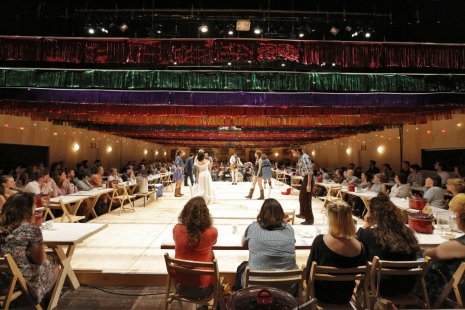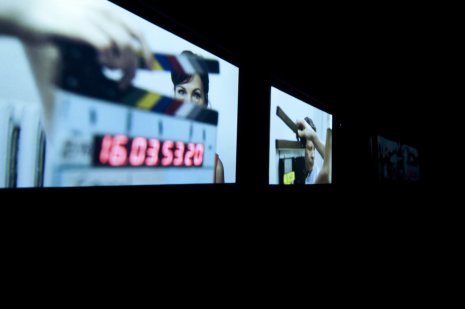This email exchange between Daniel Fish, in New York, and Tom Sellar*, in New York and New Haven took place in March and April 2017.
Tom Sellar:
The Herb Alpert Award is a great occasion to take stock of what you’ve done and where you’re going as an artist. Your work to date reflects a significant shift: You began as a director, working primarily (but never exclusively) on staging productions centered around dramatic repertory for theaters nationally. But in more recent years you’ve often chosen to originate projects yourself--often in forms overlapping with theater, like video art, and create them with a broader range of institutional partners. Is this a heartfelt evolution from one form to others? Is it a rejection of the hierarchies of traditional theater making? Or is it just happenstance, the logic of where collaborations led you?
Daniel Fish:
It is a heartfelt evolution. It’s also the result of necessity and a certain amount of coming to terms with my own preferences and limitations as well with what I saw as a shift in the field from the time I came into it. And yes, a part of it is just the logic of certain projects and collaborations and mundane stuff like people’s schedules. Several years ago, it became clear to me that the work I was interested in making was going in a different direction from the theaters that were producing it were. I knew I had to adjust my concerns and process or produce the work myself. In a sense, the greater shift would have been not to shift: to make compromises that I wasn’t interested in or capable of making. In some ways it was very natural; I trained in Performance Studies at Northwestern where my teachers were Frank Galati and a brilliant man named Leland Roloff, a Jungian analyst who taught performance art and poetry. You can trace the shift you mention back to my time there.
I’ve never really bought the distinction between dramatic repertory and work that is defined as being outside of it or post or non-dramatic or whatever people call it now. It’s all raw material. It seems to me there’s nothing inherently more dramatic about Hamlet on the page than there is about a fragment of narrative fiction or a talk show interview or a de-classified military document. Any one of these becomes dramatic when an actor or a singer has the nerve to get up in front of a group of strangers and tries to make it live. The thing about genre is that when I look at a painting, a sculpture, a film, when I read a book, I see and hear theater. Is this a rejection of the hierarchies of traditional theater making? I think it’s a rejection of assumptions. But I was just doing what I needed to do to make the work. And maybe the several months I spent in Berlin starting to learn to German and going to The Volksbühne had something to do with it too.
TS:
I’m really interested in what you just said about not accepting a hard distinction between dramatic repertory and performance created without a framing play text. After all, historical plays were created from literary and mythological, poetic and historical sources of all kinds too. And theater artists have always “devised” stage aesthetics in response to them, which is one of your strengths and perhaps characteristics as a stage artist—finding an original form to accommodate a source, rather than the other way around. If you see so much fluidity between drama, theater, and performance, do you think of your work in any categories at all? Maybe based on the source material? Adaptations from novels, for instance (David Foster Wallace/A Radically Condensed and Expanded Supposedly Fun Thing I’ll Never Do Again) versus musicals (Rodgers and Hammerstein’s Oklahoma!), or work driven by light, set, music and fog in the studio (Don’t Look Back)?
DF:
Well no, but your suggestion sounds like a good idea. Thanks for that! The source material is a starting place; sometimes the material changes, often radically, throughout the process. When I started working on what would become Eternal, I was working with actors Thomas Jay Ryan and Christina Rouner on making something from the film, Woman Under the Influence. I pretty quickly realized that my love of the film was not enough to build a show on. So I began to scrape away at what I was interested in and that led me to thinking about endings and to transcribing the last scenes of about sixty films. We worked on those scenes for a while and then eventually discovered that what the piece wanted to be was the same scene, played repeatedly for two hours without stopping. While the text changed as the project developed, Tom and Christina were always part of it and the piece was made on and for them.
Sometimes material that’s been cut has a way of coming back indirectly, invisibly, silently, as it did with Don’t Look Back, which was inspired by the films of Chantal Akerman. But I wonder...do you think the talk about form is a way of avoiding talking about the harder questions a work may be trying to ask— or a way of avoiding the fact that the work may not be asking those questions at all, or of concealing one’s response or lack of response? Sometimes the surface is just the surface and sometimes, as Douglas Sirk said, it’s a manifestation of the depths. The work that moves me is what it is because that’s what it needs to be. And if the work communicates with that level of authenticity, if it feels inevitable (and the degree to which it does either of these or not is highly subjective), then I don’t think about genre or form at all. Is that a confusing answer?
TS:
It's a good answer. Let's talk about those harder questions your work has been trying to ask. Do you see recurring preoccupations linking the projects you've made since you started working more independently in recent years?
DF:
I suppose I had that one comin’. I’m reluctant to state what the preoccupations may be because if I do, it can interfere with an audience’s experience of the work. That’s a power the audience gets to have, not me. If I state what it’s about, it robs them of something potentially meaningful and fun. But since we are talking more generally…okay, why not. I ‘m interested in presence, repetition, in seeing how essential the parts that make up a performance can be. I suppose these are not really new concerns for me, but I think I’ve been pushing myself and my collaborators to go further. Doing away with text entirely or seeing what happens when nothing happens are two examples. These are acutely on my mind today, since I heard the news that Trisha Brown died. I loved her work.
TS:
Are you saying you want to let the performance speak for itself? Rather than outlining thematic interests for you outside of the projects? If so, to me that is also illuminating of the space you work in now -- between directing, where conventionally the theater maker uses the play as a kind of prop for ideas behind it and around it, and some more expansive, generative kind of performance making, where the ideas are kind of inseparable from the event itself?
DF:
They are inseparable. It’s not that I want the performance to speak for itself. My reluctance is rooted in a faith in the audience and an awareness that my collaborators and I spend a lot of time and energy crafting a show so it looks and sounds and feels the way that we want it to. Once we do that, and show it to people, then it belongs to the audience. That’s it. I heard the writer C. E. Morgan talk about this. She really nailed it. A show is an opening, an offer to the audience: we made this thing very carefully. We had a good experience making it and we hope you have your own good experience watching it.
TS:
I can see your affinities with Trisha Brown in your abiding interests in presence, spectatorship, time, and experimentation with fundamental elements of theater. Which other artists have stimulated your thinking around those questions?
DF:
Chantal Akerman, Robert Irwin because their work asks me to slow down, to take in stillness and what may initially seem like nothing. After being with an Akerman film for the length of it, or spending real time with one of Irwin’s line paintings or scrim installations, they become communicative and absorbing. The work of Frank Castorf, and his designer, the late Bert Neumann, at Berlin’s Volksbühne: the anarchy and the sense of life being lived in a crazy, intense, funny, exhausting and deeply moving way. Another thing is that liking the work is just not part of why people go the theater there. That’s great.
TS:
I share your sense of profound discovery and transformation from the fervor of the Berliner Volksbühne under Castorf’s directorship, now concluded. Can you say more about that? Was it the sense of formal possibility for theater? The political engagement? The altered sense of ensemble and institution? For me, Christoph Schlingensief was at the center of it too – an extraordinary artist who challenged so many boundaries of the stage.
DF:
Schlingensief was amazing and for sure really tossed boundaries out the window—like he didn’t even believe in the window—the most extreme of those extremists. And so free. Have you seen his Hitler movie shot with a hand held camera and a flashlight? It’s terrific. One thing I love about the VB is that the acting in a Castorf or Pollesch production is unlike anything I’ve seen anywhere else, ever. Actors like Martin Wuttke, Sophie Rois, Volker Spengler, Kathrin Angerer: onstage, these people seem to be themselves and inside of a show at the same time in a way that I never question—it's totally authentic, true and I never for a second find myself thinking about the damn choices they may not be making. They never pander to the audience and yet they need the audience. It's like they are living through this intense thing and we are lucky to be there and by the end of seventy minutes or six hours, I somehow always have the feeling that we (the actors and the audience) have gotten through it together. So we all participate in this profound way without ever being overtly asked to do so.




